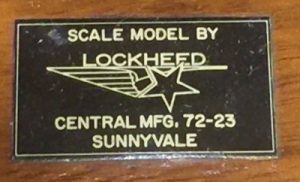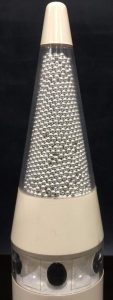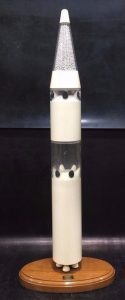Some time back there was an EBay auction for a Polaris display model with a difference. The missile itself seemed normal enough, but the warhead was distinctly unusual. It was a plexiglas cone filled with small metal spheres:
Assuming that this model is truly official (it seems to be, but who knows), then it would appear that Lockheed gave some thought to a Polaris armed with biological or chemical warheads. I would speculate that this probably isn’t a biological weapon… biowar agents are usually fairly slow and you generally want to distribute them quietly, while a SLBM is terribly fast and not at all sneaky. My guess is that the metal spheres are the M139 bomblets, designed to carry 590 grams of Sarin nerve gas. The M139 was loaded on the Honest John and Pershing missiles in the 1960’s. The preceding design was the M134 bomblet, some 334 of which could be carried by an Honest John, as shown in the display piece below:

I have doubts that the Navy would load Sarin or bioweapons on board a submarine… seems to be just asking for trouble. Perhaps this was for a land-transportable missile, carried on a trailer behind a truck. Lockheed tried to sell just such a thing a few times with no success.



This is not a Polaris as the model shows thrust termination ports (the black circles) around the top of the first and second stages which the Polaris A3 did not use.
I was a MT in the Navy and worked on the Polaris A3 (in fact, I crawled inside them) while assigned to an SSBN in the 70’s and it did not have any thrust termination system. The 1st stage fired till it ran out of fuel, and the 2nd stage fired until it reached the XYZ vectors/position required for warhead separation, at which time the 3 MRV warheads “popped” off via torsion springs with the remains of the 2nd stage and equipment section continued on it’s merry way.
Now the Poseidon (successor to Polaris) did have thrust termination ports for the second stage. But the missile shown does more closely resemble an A3 than a C3 Poseidon.
Regardless of the pedigree of the model displayed, it is an interesting thought about having Sarin loaded on the missiles. I’d rather work with a Nuclear warhead. Thanks for posting!
Some good points. This may still be a Polaris, just one greatly modified. As mentioned, i just can’t see a missile like this firing from a sub, but rather from land; consequently, the range might have been *extremely* variable… anywhere from the maximum range attainable, to just over that there hill. In which case thrust termination of both stages would have been necessary… for very short ranges – perhaps a hundred miles, maybe even less, who knows – the first stage would need to shut down relatively shortly after launch. Ranges between what just the first stage could attain and what could be attained with the full performance of the second would be achieved via thrust termination of the second stage.